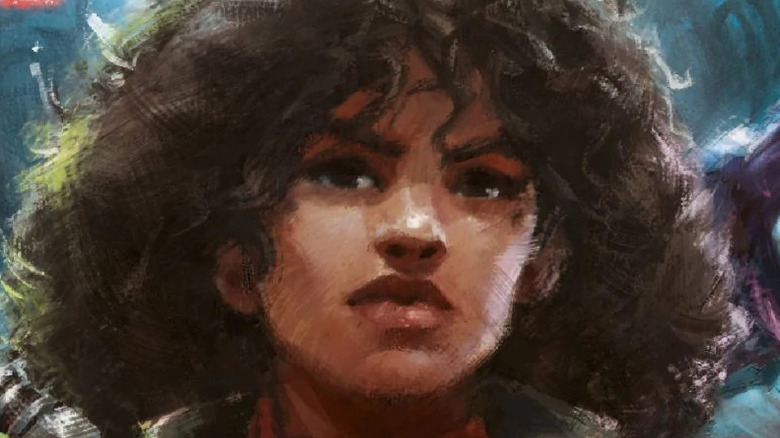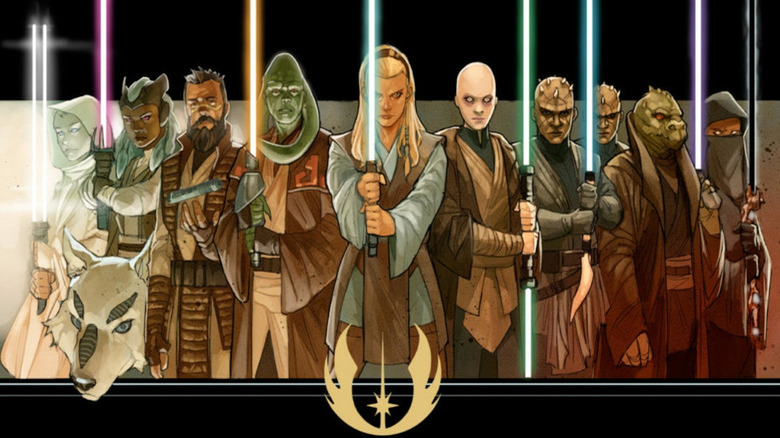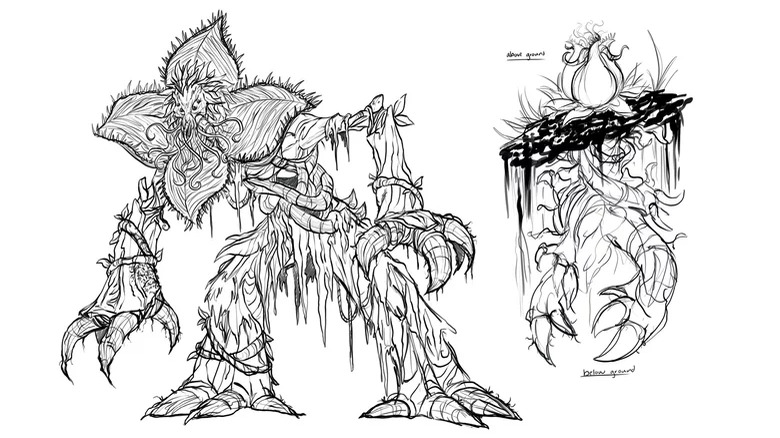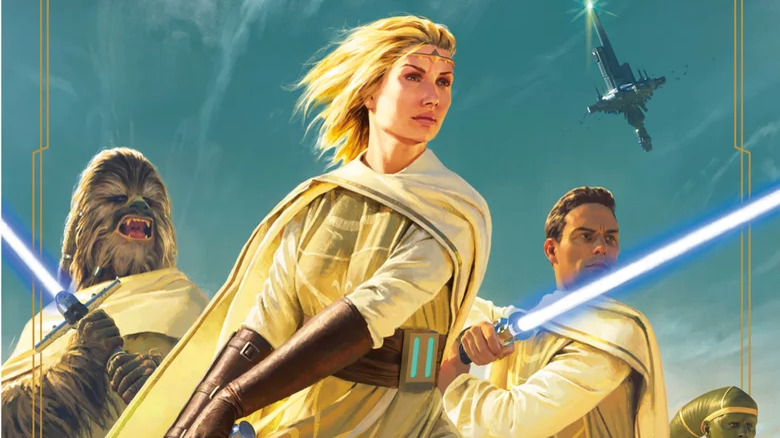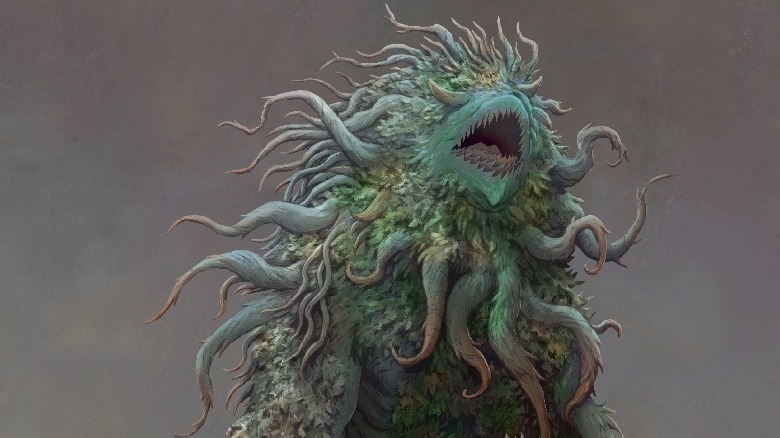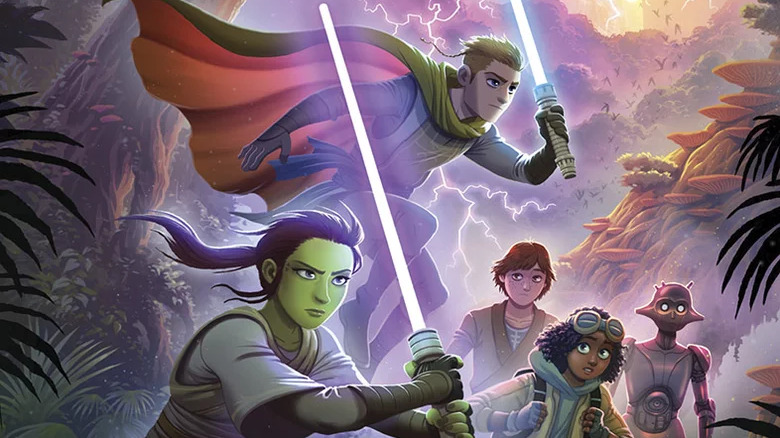Author Kristin Baver And Artist Grant Griffin On New Book The Art Of Star Wars: The High Republic - Exclusive Interview
The growing set of multimedia works set within the "Star Wars: The High Republic" world all tell the tale of an era when the Jedi are at the peak of their powers. It's an earlier era of confidence, success, relative peace, and a distinct lack of the ascendant Sith, which nearly eradicated the Jedi order from the "Star Wars" universe. With that combination of "Star Wars" creativity and the affluence and beauty of a civilization at a healthy point, these creative projects undoubtedly have the gorgeous art that characterizes some of the best work of "Star Wars."
In the new book "The Art of Star Wars: The High Republic (Volume One)," author Kristin Baver gathers tales, information, and (most importantly) art from the literature of the High Republic, showcasing the vast swaths of creativity that went into building the series' beautiful worlds and everything in them. In an exclusive interview, we asked author Kristin Baver and "The High Republic" artist Grant Griffin about the series' design, its conceptual evolution, the terrifying Nihil, and more.
It was the right time for a series focusing on unity and overcoming fear
You began work on this book just as we all started quarantine. What was it like to work on a project like this at such a strange time?
Kristin Baver: I spent the summer of 2020 writing "Skywalker: A Family at War," so when this book came along later that year, I was delighted to have another project to focus on. The launch event for "The High Republic" in February 2020 was the last time I traveled for work that year, so it left a deep impression on me, not only because of the magnitude of the publishing initiative but [also] because of how much my day-to-day work changed immediately after.
However, once I began reading the stories and talking to the creators, as a fan and a professional I was responding to the themes and messages they had seeded long before COVID-19 was in the headlines. As Charles Soule notes in the book, it was the right time for a series that focuses on unity and overcoming fear amid the ripple effects of disaster. And I couldn't believe my luck in getting to play a part in it by working on the story of not only the art but [also] the making of the initiative.
A lot of mythological elements went into the design of this era's Jedi Knights. Tell me about that.
Baver: The team had some really gorgeous mood boards that they were bouncing off of, featuring pre-Raphaelite paintings, Ralph McQuarrie originals, and other pieces that tapped into our own Arthurian legends of [the] Knights of the Round Table. But I think having their meetings at Skywalker Ranch also played a role. The grounds were constructed for creativity and collaboration by "Star Wars" creator George Lucas, including a massive reference library that delves into history and mythology for future filmmakers and storytellers to peruse.
"Star Wars" is our own modern mythology, but the DNA of the galaxy from the beginning has been in Joseph Campbell's hero's journey and other formative works that pull from mythological elements.
The scariest thing about the Nihil is you can't reason with them
The first issue of "Star Wars: The High Republic Adventures," "Collision Course," centers on an emerging relationship between two young women, Lula and Zeen. It's a great contemporary addition to "Star Wars" lore. Why was that so important?
Baver: I think everyone who came together for this initiative was cognizant that while everything needed to feel like part of the "Star Wars" galaxy we know and love, writing for the modern audience also meant ensuring that any fan could pick up "The High Republic" and see themselves in it. I'm not sure there's anywhere that's more important than in the all-ages comic, where you're reaching some of the youngest fans and newer readers. And what the writer, Daniel José Older, has done beautifully is make sure that the fact that they're two girls in love isn't a central part of their struggle with their feelings for each other.
There was a great deal of care taken with every new character that was introduced in the era, and I think you can see that reflected in the designs and the stories as they play out. Storytelling must, on some level, reflect the world we live in to remain relevant.
I like the idea that since the Jedi aren't at war here, there were a lot of discussions about how to create worthy adversaries in this very different "Star Wars" context. Tell me about those decisions.
Baver: The difficulty from the beginning was that the creators couldn't rely on the Sith to be the problem this time around. There's story precedent in the prequel trilogy that makes it very clear the Sith haven't been seen for centuries.
However, I think the Nihil, and the Leveler in particular, was an elegant solution. Here you have a group hellbent on anarchy — when the Jedi are all about order and balance — with a secret weapon that's a Jedi killer! How do you remain calm and not let the fear overcome you when you're watching some of the most powerful Jedi you know be obliterated by such a thing?
Plus, of course, you have the Drengir, which are a different shade of scary. The Sith deal in absolutes and they aim to be wholly evil. But the Drengir aren't villainous by choice; they're simply hungry, and meat is what's on their menu.
I love the Nihil's concept, with their terroristic, guerilla-warfare style of challenging the Jedi. How did that concept evolve?
Baver: The look of the Nihil has some of its roots in the British punk movement aesthetically, but that anti-establishment mentality is also evident in the way the group is written across Phase I. I think the scariest thing about the Nihil is that you can't reason with them. Their goal is turmoil, so you're not going to talk them out of that. They're selfish, and they'll come in and take whatever they want.
We'll definitely see the High Republic in other media
Tell me about the process of getting this art book together.
Baver: I loved spending time just looking through the artwork and then sitting down with the artists to talk through each piece. I've been a writer most of my life, but my affinity for art has never translated into any real talent as an illustrator or painter, so I am in awe of the skill and technique it takes to create the work. But I think the best part was hearing about all the various places each contributor found inspiration, from "The Fly" to "Kamen Rider" and even a kitchen drawer full of gadgets. Good ideas can come from anywhere, and the creative process itself can be so mysterious, even for the creator.
I had so much access to not only the art but also the people involved, and each one was incredibly generous with their time and candor. Something I've learned from reading other books about the making of films is how important it is to show the process and all the bumps and wrong turns along the way. It's interesting [not only] to consider what might have been if an artist or director had stuck with an earlier draft or a different choice, but also to understand our own process as creative people and learn to give ourselves some grace when whatever we're working on isn't perfect from the very first try.
And I'm grateful for the whole team at Abrams, who took my manuscript and image captions and then put them together in this beautiful layout.
"The High Republic" was designed to be an entirely different continuity from all the "Star Wars" adaptations we've seen so far. Do you think we'll ever see it in another medium?
Baver: It's all part of the greater "Star Wars" continuity, which is part of what's so fun about the current lore and how a comic book or a novel can connect back to a character you've loved on film for 40 years. We'll definitely see the High Republic in other media! We've already experienced it in virtual reality, and Lucasfilm has announced that "The Acolyte" will explore the final days of the era of the High Republic in live action, and "Young Jedi Adventures" will bring the period into animation. With just a glimpse at the cast and some of the characters for those two projects, I'm super excited to see how they factor into what we already know about the "Star Wars" galaxy!
Leaning into spaghetti Westerns for the Jedi Rangers
Grant, your work was essential for those first five pieces of art that began the process of creating "The High Republic." Tell me about that process and those initial designs.
Grant Griffin: There is always some trepidation when stepping into the "Star Wars" universe, but mostly, I was excited to contribute to a new era of "Star Wars" and inspire the next generation of fans.
Phil Noto set the tone for the Jedi of "The High Republic" and gave them their heroic Knights of Camelot feel. The first designs I explored dealt more with the wilder parts of space, outside the borders of the Republic's protection. A few of the standouts for me were designing the Nihil, Jedi Rangers, and playing around with what R2-D2's great-grandfather looked like. The initial idea for the Nihil [was] an anarchistic group of punk-rock space Vikings. I pulled heavy inspiration from the '70s punk movement in Britain and gave it a "Star Wars" makeover.
For the Jedi Rangers, we wanted to keep the noble High Republic look, but more weathered and beaten down. The Ranger protects the fringes of space and lacks the glitz and glamour of their council counterparts. For these Jedi, I wanted to walk the line between nobility and outlaw sheriff and leaned into the spaghetti Western elements of "Star Wars."
How was your work here different from your work in "Star Wars: Myths & Fables"?
Griffin: If I am working on illustrations or conceptual design, at the heart of it all, my focus lies in storytelling. The big difference [with] the "High Republic" work was the ability to solely focus on the characters and creatures themselves. This allowed more freedom to explore how these characters thought, carried themselves, and presented themselves to the outside world, rather [than] through characterization or the gear they carry. When working on the illustrations for "Myths & Fables," I was looking at the larger picture and focused on how characters interacted with others and their environments.
The key to Star Wars designs is their readability
"Star Wars" design principles are so smart, and for "The High Republic," that became a three-second rule you were quoted about. Can you discuss that further and give an example of how it comes into play?
Griffin: I wish I could take credit for the "three-second rule" quote; it sounds good, but it did not come from me. The key to "Star Wars" designs and what made Ralph McQuarrie's concepts so smart was their readability. There are numerous colorful characters and species spread across the galaxy; each one has an iconic look and feel. Without thinking, you can catch a character in the background, and just by its shape language, you know what spectrum of good or evil they fall into. It's that kind of clarity that makes "Star Wars" characters so iconic.
You designed the art book cover. Tell me about the process of choosing its subject and about creating it as a whole.
Griffin: This was one of the more challenging covers I have had the pleasure to illustrate. I was caught between a quickly approaching deadline and many hard back-and-forth discussions on which of the many key High Republic characters we should showcase. We spent a lot of time up-front, dialing in who the characters would be and how best to portray them.
At one point, we had seven different layouts, each with its own flavor. One of my favorites involved the helmet of Marchion Ro in space (a[n] homage to the classic "Empire Strikes Back" poster illustrated by Drew Struzan), his red eye framing three Jedi. Another idea featured a superimposed Yoda hand outstretched with the other Jedi gathered in the light of his saber. In the end, we settled on a more classic shot with our heroes looking off into the distance and bracing for the storm.
"The Art of Star Wars: The High Republic (Volume One)" is now available in bookstores.
